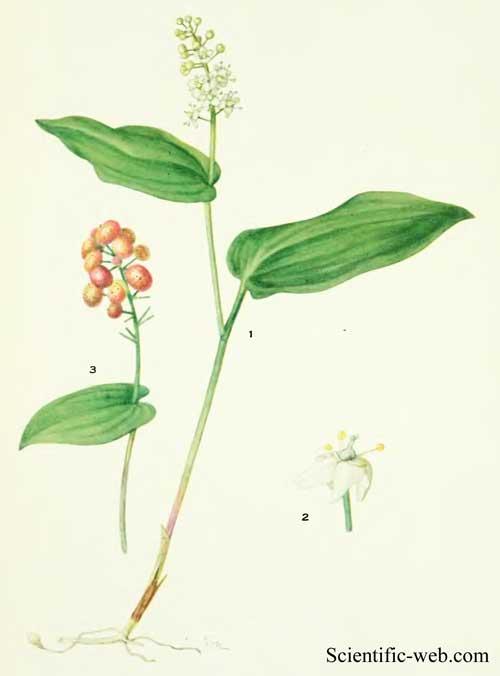
Maianthemum canadense
Classification System: APG IV
Superregnum: Eukaryota
Regnum: Plantae
Cladus: Angiosperms
Cladus: Monocots
Ordo: Asparagales
Familia: Asparagaceae
Subfamilia: Nolinoideae
Tribus: Polygonateae
Genus: Maianthemum
Subgenus: M. subg. Maianthemum
Sectio: M. sect. Maianthemum
Species: Maianthemum canadense
Name
Maianthemum canadense Desf.
Synonyms
Convallaria canadensis (Desf.) Poiret
Maianthemum canadense f. oswaldii Moldenke
Maianthemum canadense f. trifolium (Pursh) Vict.
Maianthemum canadense subsp. interius (Fernald) A.Löve & D.Löve
Maianthemum canadense var. carolinianum Butters
Maianthemum canadense var. interius Fernald
Maianthemum canadense var. ovale (Pursh) Butters
Maianthemum canadense var. pubescens Gates & Ehlers
Smilacina canadensis Pursh
Smilacina canadensis var. ovalis Pursh
Smilacina canadensis var. trifolia (Desf.) Pursh
Smilacina eschscholtziana Andrz. & Bess. ex Baker nom. inval.
Styrandra canadensis Raf.
Unifolium bifolium var. canadense (Desf.) Farwell
Unifolium bifolium var. ovale (Pursh) Farwell
Unifolium bifolium var. trifolium (Pursh) Farwell
Unifolium canadense (Desf.) Greene
Unifolium canadense var. interius (Fernald) House
Unifolium eschscholtzianum W.Wight ex J.P.Anderson comb. inval.
References
Annales du Museum National d'Histoire Naturelle. Paris 9:54. 1807
USDA, ARS, Germplasm Resources Information Network. Maianthemum canadense in the Germplasm Resources Information Network (GRIN), U.S. Department of Agriculture Agricultural Research Service. Accessed: 07-Oct-06.
Maianthemum canadense (Canadian may-lily, Canada mayflower, false lily-of-the-valley, Canadian lily-of-the-valley, wild lily-of-the-valley,[2] two-leaved Solomon's seal[3]) is an understory perennial flowering plant, native to Canada and the north-eastern United States, from Yukon and British Columbia east to Newfoundland, into St. Pierre and Miquelon.[3] It can be found growing in both coniferous and deciduous forests. The plant appears in two forms, either as a single leaf rising from the ground with no fruiting structures or as a flowering/fruiting stem with 2-3 leaves. Flowering shoots have clusters of 12–25 starry-shaped, white flowers held above the leaves.[3]
Description
Plants grow to 10–25 cm (4–10 in) tall,[4] arising from branching rhizomes that have roots only at the nodes. Plants may be one-leaved and without fruiting structures (sterile). Fertile, flowering shoots have 2–3 leaves.
Leaves
Leaf blades are 4.5–9 cm (2–4 in) long by 3–5.5 cm (1–2 in) wide with a pointed tip. Lowest leaves are usually egg-shaped with two lobes at the base and a narrow space (sinus) between the lobes. Upper leaves are usually heart-shaped and set on a short 1-7 mm long petiole.
Flowering clusters
Clusters of 12–25 starry-shaped, white flowers are set in a complex raceme - an unbranched flowering cluster that has 1-3 (usually 2) stalked flowers per node, set at roughly equal distances along a central axis. Lowest flowers open first. Flowers stalks (pedicels) are 3-7 mm long and thin (0.2-0.5 mm wide).[5]
Flowers and fruits
The flowers are produced from spring to mid summer. They have 4 conspicuous, white, 1.5-2 mm long tepals. The fruit is a berry containing 1–2 round seeds. The berries are 4-6 mm across, mottled red in early summer and turning deep red by mid summer. Seed is produced infrequently and most plants in a location are vegetative clones, the plants spreading by their shallow, trailing, white rhizomes.
Distribution
Found in Canada from SE Yukon, southern Northwest Territories, into eastern B.C. and east to Newfoundland and Labrador, and into St. Pierre and Miquelon. Also found in northern United States from the Dakotas east, south along the Appalachian Mountains and outliers in Colorado, Wyoming Nebraska and Kansas.[3]
Habitat and ecology
Primarily a boreal forest understory species, but also found at low elevation sites in the Rocky Mountains, to 1800 m.[3] It is associated with moist woods but is also found in sandy pine woods in the north[6] and can persist in clearings.[3]
Similar species
Although most Maianthemum have flower parts in sets of 3, M. canadense plants have flowers with four tepals and four stamens, as in the very closely related Maianthemum bifolium and Maianthemum dilatatum. The range of these species do not overlap. Maianthemum bifolium is found in temperate Eurasia[7] and Maianthemum dilatatum is essentially a coastal species found from Alaska south to NW California as well as Mongolia to Japan.[8] Maianthemum trifolium is also a small herb and has a distribution similar to M. canadense, but the flower parts are in sets of 3s, the leaf bases are tapered, not heart-shaped and M. trifolium is found in wet habitat such as bogs.[3]
Subspecies
No subspecies are currently recognized, although in the western half of the range plants with hairs and consistently larger leaves have been treated as var. interius.[3]
References
"Maianthemum canadense". Integrated Taxonomic Information System.
Dickinson, T.A.; Bull, J.; Metsger, D. & Dickinson, R. (2004), The ROM Field Guide to Wildflowers of Ontario, Toronto: Royal Ontario Museum, ISBN 978-0-7710-7652-7, p.105
"Flora of North America". Flora North America Website. Flora of North America Editorial Committee. Retrieved 2021-03-22.
LaFrankie, James V. (2002). "Maianthemum canadense". In Flora of North America Editorial Committee (ed.). Flora of North America North of Mexico (FNA). Vol. 26. New York and Oxford – via eFloras.org, Missouri Botanical Garden, St. Louis, MO & Harvard University Herbaria, Cambridge, MA.
LaFrankie, J.V. 1986. Morphology and taxonomy of the new world species of Maianthemum (Liliaceae). Journal of the Arnold Arboretum Vo. 67, No. 4 (October 1986), pp. 371-439.
Porsild, A.E.; Cody, W.J. (1980). Vascular Plants of Continental Northwest Territories, Canada. Ottawa, Canada: National Museums of Canada. p. 206. ISBN 0-660-00119-5.
Sicence, Kew. "Maianthemum bifolium (L.) F.W.Schmidt". Plants of the World Online. Retrieved 21 April 2021.
Sicence, Kew. "Maianthemum dilatatum (Alph.Wood) A.Nelson & J.F.Macbr". Plants of the World Online. Retrieved 21 April 2021.
Bibliography
Blanchan, Neltje (2002). Wild Flowers: An Aid to Knowledge of our Wild Flowers and their Insect Visitors. Project Gutenberg Literary Archive Foundation.
Retrieved from "http://en.wikipedia.org/"
All text is available under the terms of the GNU Free Documentation License

